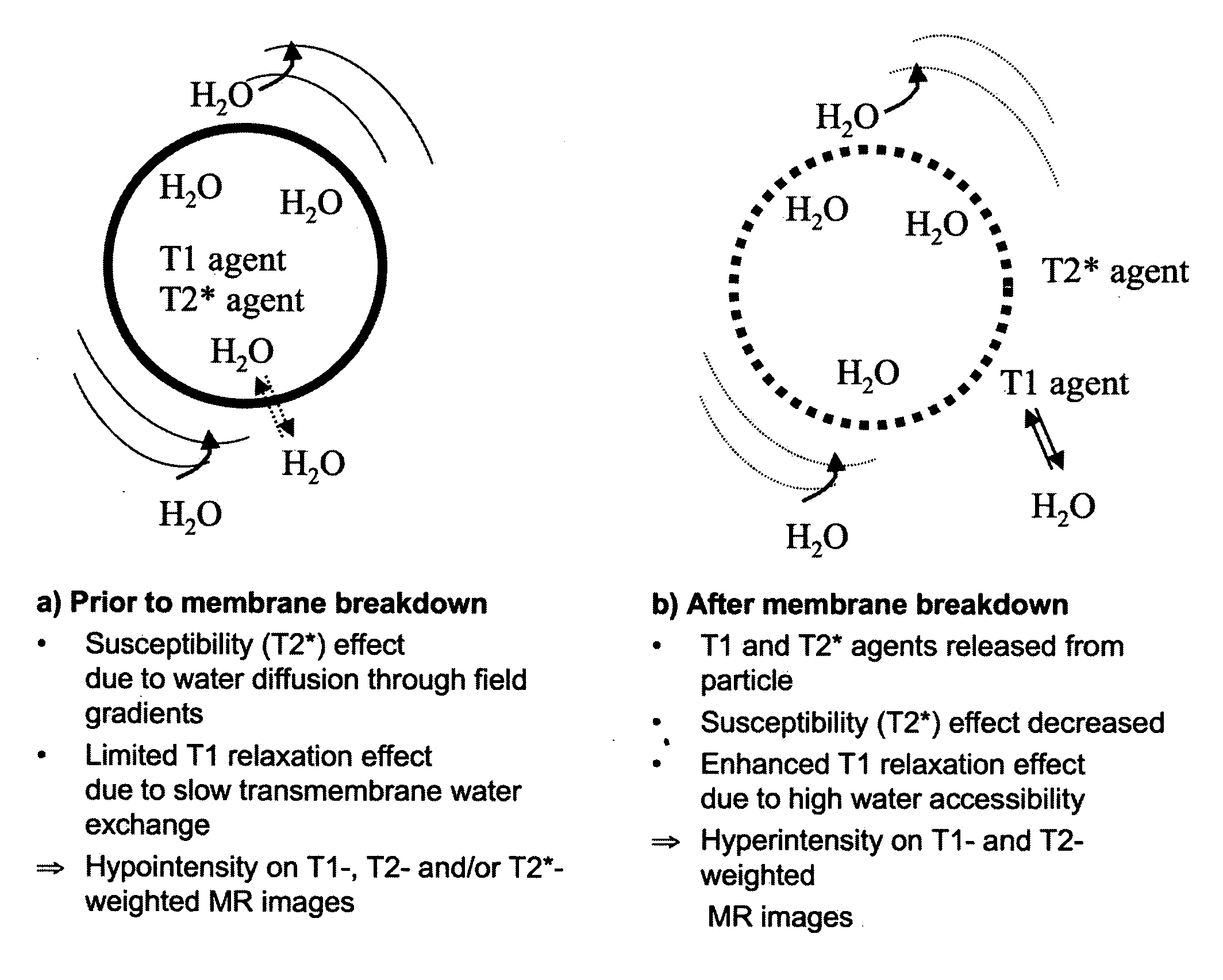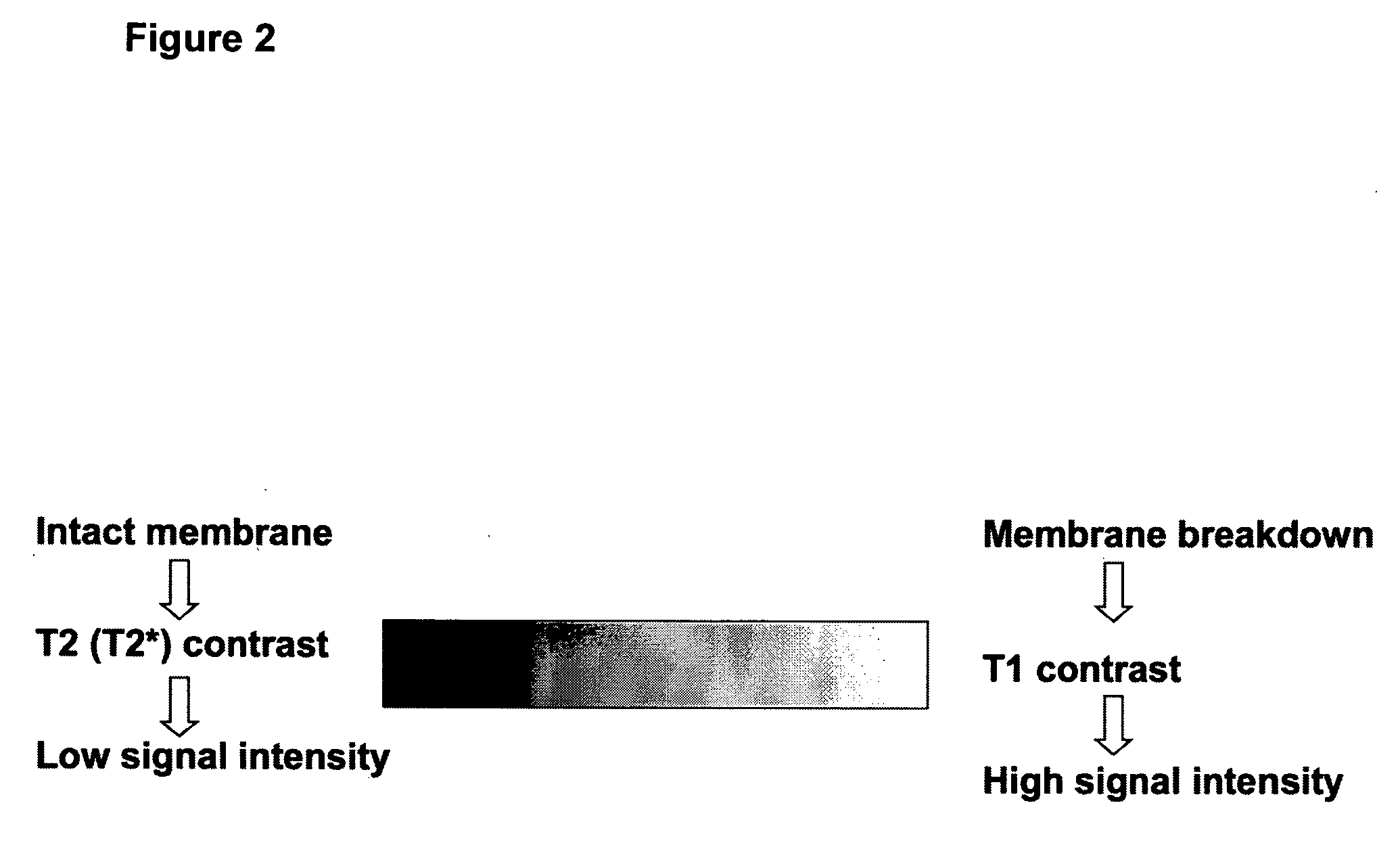MRI trackable drug delivery particles, uses and methods thereof
a technology of magnetic resonance imaging and drug delivery particles, applied in the field of drug delivery particles, can solve the problems of limited traditional medical treatment, lack of specificity, and imposing limitations on therapy
- Summary
- Abstract
- Description
- Claims
- Application Information
AI Technical Summary
Benefits of technology
Problems solved by technology
Method used
Image
Examples
example 1
Preparation and Characterization of Liposome Containing a Gd Chelate and a Dy Chelate (“Paramagnetic Liposomes”)
[0058]DSPC and DSPE-PEG 2000 were purchased from Genzyme Pharmaceuticals (Liestal, Switzerland). Chloroform, methanol, calcein, HEPES, sodium azide and sucrose were all obtained from Sigma Aldrich. GdDTPA-BMA (Omniscan®) and DyDTPA-BMA (Sprodiamide) were kindly supplied by GE Healthcare and Rikshospitalet-Radiumhospitalet, respectively, both Oslo, Norway.
[0059]DSPC / DSPE-PEG 2000 (mole %; 92:8) liposomes were prepared by the thin film hydration method. The phospholipids were dissolved in a chloroform / methanol mixture (volume ratio; 10:1) and the organic solution was evaporated to dryness under reduced pressure. Liposomes were formed by hydrating the lipid film with a pre-heated (65 deg C) 10 mL aqueous solution containing GdDTPA-BMA chelate (150 mM), DyDTPA-BMA chelate (150 mM) and 4 mM HEPES (pH 7.4). The resulting liposome dispersion at a nominal phospholipid concentratio...
example 2
Preparation and Characterization of Liposome Containing a Gd Chelate, a Dy Chelate and the Drug Marker Calcein (“Paramagnetic Liposomes Containing Calcein”)
[0063]DSPC / DSPE-PEG 2000 (mole %; 92:8) liposomes were prepared analogously to Example 1, except that the aqueous solution used for lipid film hydration also contained 20 mM of the fluorescent dye calcein. The dialysed liposome dispersion was characterised with respect to key physicochemical properties as described in Example 1.
[0064]The intensity-weighted liposome size was 88 nm. The osmolality of the dialysed liposome dispersion was 640 mosmol / kg water. The effective concentration of Gd and Dy in the dialysed liposome dispersion was 5.2 mM.
example 3
Ultrasound Treatment of Liposome Samples
[0065]For the ultrasound experiments, the dialysed liposome dispersions (from Examples 1 and 2) were further diluted with isosmotic sucrose / 10 mM HEPES (pH 7.4) / 5 mM EDTA solution containing 0.02% w / v sodium azide. EDTA was supplied as the disodium and diydrate salt from Sigma Aldrich.
[0066]The ultrasound experiments were performed with a ‘Vibra-Cell’ 40 kHz ultrasonic processor, VC754, with a 1.9 cm diameter transducer, purchased from Sonics and to Materials, Inc. (CT, US). Ultrasound with a 20% amplitude was applied for 4 minutes to the diluted liposome dispersions (dispensed in plastic flask). The plastic flasks containing liposomes were during ultrasound exposure placed in a water / ice bath to minimise any ultrasound mediated heating effect. The sample temperature rose from 10 deg C. prior to ultrasound treatment to 20 deg C. after completed treatment.
PUM
| Property | Measurement | Unit |
|---|---|---|
| temperature | aaaaa | aaaaa |
| physiological temperatures | aaaaa | aaaaa |
| Tc | aaaaa | aaaaa |
Abstract
Description
Claims
Application Information
 Login to View More
Login to View More - R&D
- Intellectual Property
- Life Sciences
- Materials
- Tech Scout
- Unparalleled Data Quality
- Higher Quality Content
- 60% Fewer Hallucinations
Browse by: Latest US Patents, China's latest patents, Technical Efficacy Thesaurus, Application Domain, Technology Topic, Popular Technical Reports.
© 2025 PatSnap. All rights reserved.Legal|Privacy policy|Modern Slavery Act Transparency Statement|Sitemap|About US| Contact US: help@patsnap.com



